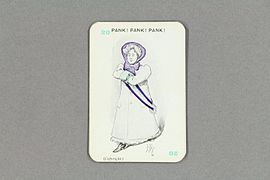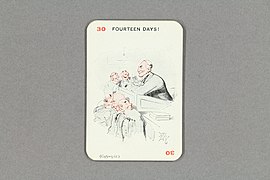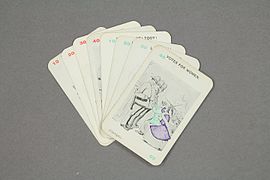Panko (game)
Panko or Votes for Women is a card game that was marketed in England from around 1909 . The theme of the game is the suffragettes' struggle for women's suffrage .
history
The first mention of the game Panko is in the magazine Votes for Women on December 10, 1909.
Panko is named after Emmeline Pankhurst , the founder of the Women's Social and Political Union (WSPU). The game was made by Peter Gurney Ltd. produced and distributed by the WSPU to draw attention to their political concerns and to arouse interest in women's suffrage in new groups of people. The game was titled The Great Card Game: Suffragists v. Anti-Suffragists! Applied.
layout
The playing cards were designed by ET Reed, draftsman for the satire magazine Punch . They show situations from the everyday life of the suffragette movement, based on historical events. Some cards show caricatures of well-known suffragettes and well-known politicians who opposed women's suffrage. The cards depicting suffragettes are printed in three colors in black, purple and green. Purple and green, along with white, are the colors of the WSPU and were generally considered to be the colors of the suffragette movement. The cards of the opponents of women's suffrage are printed in black and red.
left: trumpeter; right: a nobly dressed suffragette rejects the meal in the “Holloway Restaurant”: allusion to the hunger strikes of the suffragettes in Holloway Prison
Rules of the game
Panko consists of 48 cards. Six of them each form a group. Four groups belong to the movement for women's suffrage: the trumpeters, the suffragettes, the judicial processes and the lower house. Four groups represent the movement against women's suffrage: the police, the politicians, the judiciary and the prisons. Each group has a point value of 10, 20, 30 or 40 points, which is noted on the card.
Panko can be played with 4, 6 or 8 people who are divided into two teams: one team plays for and the other against women's suffrage. The aim of the game is to collect a complete group of six cards from your own warehouse.
At the beginning all cards are dealt among the other players. If four players are playing, the two groups with the lowest point value are removed from the game beforehand. The handing out person gives a start signal - then everyone can start making barter offers at the same time. To do this, you call out the point value of the card you are looking for, which you would like to exchange for an equivalent card from the opposing camp. You can swap with both members of your own and the opposing team.
Anyone who has gathered a complete group must announce this with the cry that is written on the cards: “Toot! Toot! Toot! ”For the trumpeters,“ Pank! Pank! Pank! ”For the suffragettes,“ Law! Law! Law! ”For the lawsuits and“ Votes for Women! ”For the House of Commons; "Help! Help! Help! ”For the police,“ Turn 'em out! ”For the politicians,“ Fourteen days! ”For the judicial officers and“ Gaol! Gaol! Gaol! ”For the prisons.
A round ends with a successful announcement of a group. The point value of the group (minimum 10, maximum 40 points) is assigned to the team. If someone mistakenly announces a full group, 20 points will be deducted from the team.
The game ends when a team has reached 100 points.
Similar games
In 1908 a card game called Holloway, or Votes for Women , which was similar to Panko, but had somewhat more complex rules of the game. Also named after Emmeline Pankhurst is the board game Pank-A-Squith , a copy of which is in the Museum of London .
Web links
- Panko in the game database BoardGameGeek (English)
- Panko in the private collection of historian Elisabeth Crawford (with photo of the instructions)
literature
- Elizabeth Crawford: The Women's Suffrage Movement. A Reference Guide 1866-1928. Routledge, London 2000, ISBN 978-0-4152-3926-4 , p. 235.
- Kenneth Florey: Women's Suffrage Memorabilia. An Illustrated Historical Study. McFarland & Co., Jefferson, NC 2013, ISBN 978-0-7864-7293-2 , p. 114.
- Meghan Lyon: New Acquisition: Panko Playing Cards. In: Duke University's David M. Rubenstein Library blog . April 9, 2012, accessed September 1, 2018 .
Individual evidence
- ↑ a b c d Elizabeth Crawford: The Women's Suffrage Movement. A Reference Guide 1866-1928. Routledge, London 2000, ISBN 978-0-4152-3926-4 , p. 235.
- ↑ a b c Kenneth Florey: Women's Suffrage Memorabilia. An Illustrated Historical Study. McFarland & Co., Jefferson, NC 2013, ISBN 978-0-7864-7293-2 , p. 114.
- ↑ Instructions from the historian Elisabeth Crawford's private collection, accessed on September 5, 2018.





